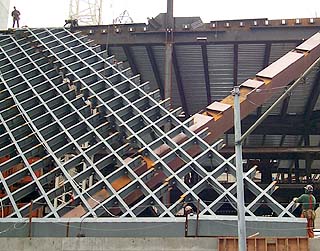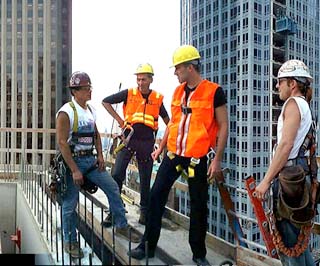|
Subscribe / Renew |
|
|
Contact Us |
|
| ► Subscribe to our Free Weekly Newsletter | |
| home | Welcome, sign in or click here to subscribe. | login |
Construction
| |
March 3, 2003
Koolhaas cathedral is taking shape
Journal Staff Reporter

Photo by Sam Bennett On the Madison Street side of the Central Library, workers recently installed a 90,000-pound raker column. The innovative diamond-grid curtainwall will provide most of the 362,000-square-foot building's lateral support. |
Like the books they will one day read inside, the engineering behind Rem Koolhaas' new Central Library just might capture a child's imagination.
Through a child's eye, the skewed concrete columns on the first floor will seem playful. "From every vantage point it looks different," said Jay Taylor of Magnusson Klemencic Associates. "The different orientation could really make a magical space."
To make the structure stand, engineers played a game of connecting the dots. Columns had to be skewed to direct the load path from the upper floors to the parking lot columns beneath the first floor.
In a typical building, the column grid is determined by the column layout of the underground parking. "Rem would have none of that," said Sam Miller of LMN Architects, which is working with Koolhaas' Rotterdam-based firm, the Office for Metropolitan Architecture.
Koolhaas' vision of making the library a series of floating platforms has spurred innovative engineering -- now on display as the building takes shape at Fourth and Madison.
Onlookers seem fascinated by the sloped load-bearing columns, diamond-grid curtain wall and giant cantilevered section over Fourth Avenue.
When the temporary steel columns are removed from under that section later this month, onlookers are in for another surprise. "It hasn't even registered with them yet that those columns are going to come out," said Taylor.
|
For passersby, it's a riddle. For engineers and designers, the Central Library stacks up perfectly.
"It's one of the most complex buildings ever done," said Taylor, "in terms of trying to achieve the architect's desire of having this steel net outside the building in a way that can be exposed and making sure we had a system to suspend the offset floor plates."
Drawing interest, of course, is all part of the plan. The form and function of the 21st century library, according to Koolhaas, should be as dynamic as the technology within its walls. Libraries resembling glorified fortresses send the wrong message, according to Koolhaas.
"In an age where information can be accessed anywhere, it is the simultaneity of all media and the professionalism of their presentation and interaction that will make the library new," he wrote in a booklet about the library.
Transparency is key, but a generic modern box would be too austere for the Central Library program, and it would not convey the complexity of the library as an information store.
Instead, the offset platforms create a dynamic form, like a stack of books (or hard drives), leaning out in places and recessed in others.
Draped over the structure, the diamond-grid wall will handle 90 percent of lateral loads. Load-bearing columns will support the gravity load, relieving the diamond grid from a code requirement to be fireproofed. In addition to housing mechanical and electrical systems, the concrete core will help absorb twisting motion.
Entering from Fifth Avenue, visitors will be treated to an open space unencumbered by vertical columns supporting the diamond grid. In essence, the columns were pulled out to the plane of the skin -- which is supported by eight 90,000-pound raker columns -- those giant diagonal columns now going up around the building.
"We wanted to keep as much of the vertical structure out of the public areas to capture the full volume of the space," said Taylor.
Members of the structural/civil team -- Arup and Magnusson Klemencic -- considered various scenarios for gravity and lateral support. The offset platform configuration meant the skin and interior columns would divide lateral and gravity responsibilities. A glass skin atop a cable net system would have offered more transparency, but no lateral, or earthquake support. Smaller diamond grids would have interfered with transparency, and larger grids couldn't support the triple-glazed glass.

Photo courtesy of OMA Architect Rem Koolhaas, second from left, recently took a tour of the $165 million Central Library, due for completion in December. Hoffman Construction is the general contractor/construction manager. |
Plus, larger diamond grids diverged from the original plan.
"Rem pulled out one of the early design concept models and said 'This is what we started with,'" recalled Taylor. "'We want to be closer to the original.'" A solution was found when engineers tightened up the grid without sacrificing much transparency.
The grid's diamonds are seven feet at their tallest and four feet at their widest. They are installed in 80-by-12-foot sections, the largest that could be trucked on Interstate 5. On the outside of the grid, the building will be sheathed in double- and triple-glazed windows manufactured by the German firm Seele.
Within the triple-glazed glass an embedded metal mesh is designed to reduce glare and heat. The system performed flawlessly in a Florida wind and rain testing facility.
"They've got to be one of the most efficient glass systems in the Northwest," said Miller. High performance sides of the building will get the triple-glazed windows, while sides not receiving as much weather, such as the north, will have double-glazing.
"It has the effect of blocking the sun, and yet when you're looking at it at certain angles it's quite transparent," he said. The grid itself will seem more transparent looking straight toward it, and more opaque the greater the angle.
An internal cistern will catch rain to be used for vegetation on the site. The library is expected to meet the Leadership in Energy and Environmental Design Silver standard.
From the 10th floor reading room, visitors will be able to navigate the Dewey decimal system along a scissored spiral that drops 12 feet per floor. The series of 200-foot-long switchbacks will allow the library to maintain flexibility in its collection and help readers quickly track down books.
At the Fourth Avenue main entrance, visitors will walk under a cantilevered section that extends 40 feet from the street to the door, creating an open space that Miller said "keeps a dialogue" with an open space in front of the 1001 Fourth Avenue Plaza across the street. He sees the sculptured design as a welcome, radical response to its more formal neighbors -- the U.S. Courthouse and the authoritative, Mies-inspired 1001 Fourth Avenue Plaza.
Straight through the revolving doors will be 20-by-20-foot metal sliding doors that open to an auditorium, and to the right an escalator leading to the third level.Throughout, Koolhaas calls for a rich palate of colors.
Once inside, a sloping ceiling to the left will be an inviting space for reading children's books. The slow compression of the space -- as the ceiling dips toward the Spring Street side -- will calm children for reading hour, Miller said.
At the third level, on Fifth Avenue, there will be a dramatic public gathering space.
The Central Library should realize Koolhaas' vision as an "information storehouse, orchestrating the coexistence of all available technologies" to manipulate information.
It's optimized to perform, from an engineer's and a user's standpoint. "It's a cathedral for learning, if you will," said Miller.


